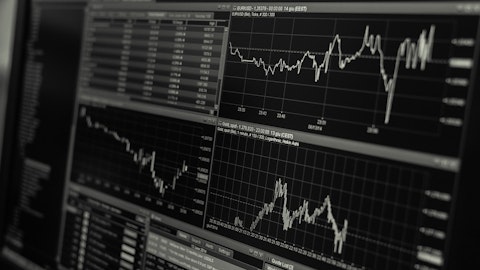Darren Woods: Good morning, Sam. I would — I guess I’d take exception to the characterization that you’ve laid out there. It’s not a function of the organization throwing additional nickels and dimes. We have pretty focused work programs to drive value here and frankly any discussion about spending additional money or making additional investments above and beyond what we’ve planned for has to come to the management committee. And so we’ve got pretty tight controls around making sure we understand what’s the value proposition, how unique is the value proposition. This is not something we just turn loose to the organization and they start throwing on money as and when they see the opportunities to do that. So that’s I think, the characterization that it’s hard to hang on to this.
I would think — I would point to the success that we’ve had to date where we’ve delivered what is a very accretive advantaged set of capital projects. I think our track record demonstrates that we are not about going after volume or going after marginal investment opportunities. These things have to be unique. The hurdle to get into the capital plan is pretty high. We have — if you look across the industry, we have a clear understanding of cost of supply. We know where we sit on the cost of supply curve. We know as new projects or opportunities come forward, we look at those in terms of where they sit from a competitive standpoint. They have to have a structural advantage. They have to be robust and resilient to the bottom of cycle conditions.
If you lay all those conditions on, it’s a fairly tight funnel that people have to get their spend through. And that doesn’t change. That has not changed. And so I would just say, if we spend additional money, that money is going to deliver more than what was in the base plan frankly because it’s on the margin. And I’ll come back to, at the end of the day, we’re not judging ourselves by basing — by hitting some number that we’ve, or guidance that we’ve given from a year ago. We’re judging ourselves on the ability to generate advantaged projects. And again, I just point you to the results that we are delivering. To grow earnings on a compounded basis at twice what the nearest competitor has done, or to grow cash flow from operations at twice what the next nearest competitor has done, doesn’t come from investing in things that don’t have the advantage that I just talked about.
So I think our track record and the results that we’re delivering demonstrate that the approach that we’ve taken here is working, and we’re not going to vary off of that approach.
Kathy Mikells: And then I’d just add one more comment, and that is, we almost take for granted how many projects we’ve actually been able to pull forward and deliver either on time or ahead of time. And Payara is a great example of that. It was originally targeted to actually start up in 2024 and we were able to pull it forward. We were then able to pull forward incremental well drilling in order to get that FPSO up to operating nameplate capacity in an extraordinarily short amount of time. I’d say this is one of the areas that really differentiates ExxonMobil from other companies. Our top — really top performance and execution and pulling projects forward is always a positive economic decision, right, because we’re going to end up then getting the benefit of the profits from those projects sooner or later. So very much a decision that’s aligned with driving value, which is what sits behind all of our decision making.
Sam Margolin: Thank you.
Operator: The next question is from Jason Gabelman of TD Cowen.
Jason Gabelman: Yeah, hey, good morning. Thanks for taking my questions. I first wanted to get your take on the outlook for the chemicals market going forward. 2023 was a bit of a trough year. Some of the industry participants are saying maybe we’re getting close to turning the corner. And that would be meaningful given all the underlying investments that Exxon has made in the chemicals business. So just wondering your view on potential for market improvement and seeing the full force of some of those investments come through.
Darren Woods: Sure. Good morning, Jason. Yeah, I think I would concur with your characterization of 2023 as being kind of at the bottom of the trough. It was definitely a challenging year, well below, I think, the bottoms of previous cycles. But I would say that, and we’re quite proud of the fact that the investments that we’ve brought on were earnings and cash positive in the bottom of the cycle, which frankly is exactly in line with — I was just talking about the strategy that we have and the criteria that we require our projects that they have to be robust to bottom of the cycle conditions. And in the chemical business, we definitely demonstrated that, that the projects — the new projects that we’ve brought on, that have some run time in them, are earnings and cash positive, even in these very challenging conditions.
So I think like many others in the chemical industry, we’d like to see us come out of the trough and when we do, our expectation is the capital that we’ve brought on will obviously be performing even better with better margins. I would say as well with respect to turning points, we have seen some — we certainly saw in the fourth quarter some slight improvements. There’s still a lot of capacity that’s come on out there. We still see a reasonably good growth, particularly for ExxonMobil in our performance product category. We have set some pretty aggressive targets to grow our high performance, high value chemical products and we’re seeing that happen. So we feel really good about the pipeline and the development of our sales. And then the question is when does the broader industry turn and you start to see margins improve?
My expectation is 2024 might be marginally better than 2023, but we’re not expecting significant change in the vector, but more of a gradual one as we work our way through all the supply that’s come on in the recent years and some of the supply will come on in 2024 and 2025. So I think it will be a gradual recovery but frankly one that we feel very comfortable with based on the advantages that we have with our capacity, the advantages that we have with our footprint, and the flexibility we have to optimize on feed and products. So we’re positioned for this kind of market. I think the results demonstrate that. And we’re going to ride it and see where the market goes.
Jason Gabelman: Got it. Thanks.
Operator: The next question is from Paul Cheng of Scotiabank.
Paul Cheng: Thank you. Good morning.
Darren Woods: Good morning.
Paul Cheng: Darren and Kathy, I want to ask about the trading operation. I think it seems like it’s a very good trading year for you and a lot of your peers in Europe. Can you help us to maybe quantify that? What is the trading benefit for the year, whether in terms of millions of dollars or in terms of improvement in the return and whether that you think that is a repeatable? And after more than the last two or three years, what have you learned? Is there anything that you will do differently going forward in your trading operation? And whether you see the first quarter optimization opportunity set, is it similar to what you’ve seen in the fourth quarter, or is it getting worse or getting better? Thank you.
Darren Woods: Yeah, thank you, Paul, and good morning. I’ll give you a perspective and then let Kathy build on that. And maybe just to go back in time a little bit, we talked about the trading opportunity within ExxonMobil for quite some time. I think there’s some skepticism out there as to whether we could actually build that business. But the foundation of our trading operations is a function of the global footprint that we have, the span of the businesses that we have, the integrated nature of the businesses that we have that we felt like gave us a physical footprint and presence in markets all around the world to effectively trade on and to build a business from that footprint and obviously the perspectives and insights that come with operating that footprint in those mix of businesses.
And that, I would say as we’ve grown our trading capability on that premise, optimizing our assets, building on our assets, that it has proven to be very effective, that that strategy is bearing out and that we see continued opportunity to grow that. And I think as we’ve talked about here, we were going to take a very measured approach and we weren’t in a hurry, we weren’t going to rush through this, we were going to make sure that what we do is structurally sound that we’re not — and that we’re managing the risk as well as capturing the rewards and we’ve been doing that. So 2023 I think was off of the highs we saw in 2022 because of where the market is at, but still reflected, I think, very solid contributions based on the capabilities of the organization that we have been building.





